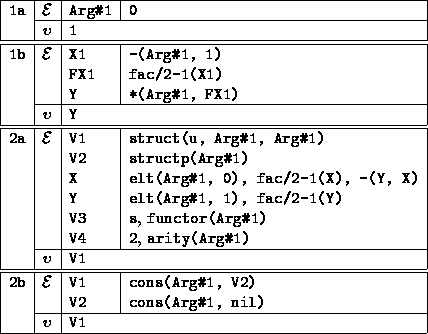




Next:
Up: Transforming Relational Languages
Previous: REL RELFUN Functions
 The next transformation step takes all deterministic clauses totally
apart: an internal representation, called
The next transformation step takes all deterministic clauses totally
apart: an internal representation, called  , is created, in which
variables are associated with expressions (
, is created, in which
variables are associated with expressions ( stands
for environment because this data structure strongly resembles
the sort of environments used for unification
stands
for environment because this data structure strongly resembles
the sort of environments used for unification  in
PROLOG
in
PROLOG interpreters). The return value is represented by
interpreters). The return value is represented by  .
.
This structure is needed for several reasons:
- all arguments of subqueries have to be ground; this often
requires reordering of premises
- unification
 has to be done at
compile
has to be done at
compile  time (static unification),
time (static unification),
 resulting in assignments
resulting in assignments  and equality tests
and equality tests

- in LL, the arguments of a function have to be distinct variables and
cannot be arbitrary terms as in PROLOG

- common subexpressions are (statically) unified, e.g. if X is f(Z)
and Y is f(Z) occur in a clause, then X is unified
with Y, e.g. by replacing Y by X everywhere
in the clause
(this is allowed because predicates with side effects and non-deterministic
predicates are not considered)
For our example,  looks like this:
looks like this:

Note that in  a variable need not be associated with
a unique expression, e.g. in 2a, X is associated with three
and Y with two expressions. As will be shown in the following
subsection, exactly one of the expressions associated with a variable
is used to bind the variable (single assignment
a variable need not be associated with
a unique expression, e.g. in 2a, X is associated with three
and Y with two expressions. As will be shown in the following
subsection, exactly one of the expressions associated with a variable
is used to bind the variable (single assignment ); the
remaining expressions are only compared with the variable
(if one of the expressions a variable is associated with is a
constant, then the variable is not needed: it is sufficient to
compare all remaining expressions with the constant, e.g. V3
and V4).
); the
remaining expressions are only compared with the variable
(if one of the expressions a variable is associated with is a
constant, then the variable is not needed: it is sufficient to
compare all remaining expressions with the constant, e.g. V3
and V4).
 was created by (local) abstract interpretation
was created by (local) abstract interpretation
 of
each clause using the following techniques:
of
each clause using the following techniques:
- normalizing heads: all head terms are moved into the
body, leaving Arg#
 as the only head terms
as the only head terms
- normalizing lists and structures: all lists and
structures are transformed into the LL constructors,
selectors, and test predicates (cons, car,
struct, etc.)
- static unification:

 all unification is translated
into environment entries in
all unification is translated
into environment entries in  just as a concrete
PROLOG
just as a concrete
PROLOG interpreter would do: in clause 2a,
s[A, B] is s[X, Y] has been used to unify A with
X and B with Y
interpreter would do: in clause 2a,
s[A, B] is s[X, Y] has been used to unify A with
X and B with Y
- unification of common subexpressions: static unification is
not only used for explicit unification (is) but also for
common subexpressions: the output value
of clause 2a, V1, is built using the original
input argument Arg#1 without re-creating s[X,Y]
and s[A,B]: V1 = struct(u, Arg#1, Arg#1)





Next:
Up: Transforming Relational Languages
Previous: REL RELFUN Functions
The next transformation step takes all deterministic clauses totally
apart: an internal representation, called
, is created, in which
variables are associated with expressions (
stands
for environment because this data structure strongly resembles
the sort of environments used for unification
in
PROLOG
interpreters). The return value is represented by
.
looks like this:

a variable need not be associated with
a unique expression, e.g. in 2a, X is associated with three
and Y with two expressions. As will be shown in the following
subsection, exactly one of the expressions associated with a variable
is used to bind the variable (single assignment
); the
remaining expressions are only compared with the variable
(if one of the expressions a variable is associated with is a
constant, then the variable is not needed: it is sufficient to
compare all remaining expressions with the constant, e.g. V3
and V4).
was created by (local) abstract interpretation
of
each clause using the following techniques: